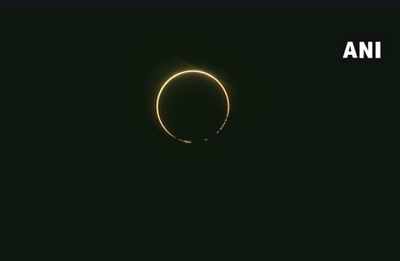
(ANI)
NEW DELHI: The first solar eclipse of the year also dubbed the « ring of fire » seen in parts of India on Sunday could help scientists understand the topology of the moon, through pictures, according to Dr N Rathnasree, Director of Nehru Planetarium here.
The rare celestial event, which coincides with the summer solstice, when the Northern Hemisphere has the longest day, is an annular eclipse and was visible in other parts of the world including African countries of Congo, Ethiopia and Yemen as well as in Saudi Arabia, Oman, Pakistan and China.
« The moon has peaks and valleys. During the solar eclipse, as the edge of the moon is in front of the sun, its peaks and valleys are visible due to bright sun rays. The sun can peek through the valleys of the moon but the sun is obscure in the mountain regions. This phenomenon is known as Baily’s beads which is common in Annular eclipse, » Rathnasree said.
« This is why the timing for the eclipse is shorter and instead of the visual of a ring of fire, we’ll see necklace after the moon swifts away from the sun, » she added.
The scientist also spoke about the sighting of the solar eclipse from various parts of the world. In Abu Dhabi, the eclipse was seen in its maximum phase and lasted for less than 30 seconds.
As it is known that the earth sees the same face of the moon. But moon being in an elliptical orbit, it sometimes changes its speed.
« During this period, the moon also peaks above and below due to which the edge image of the moon in front of the sun is different in every eclipse, explained Dr Rathnasree adding, « With this phenomenon, the moon’s topology can be known through the images captured from Earth. »
The first solar eclipse of this year takes place on the summer solstice, which is the longest day in the Northern Hemisphere.
.
